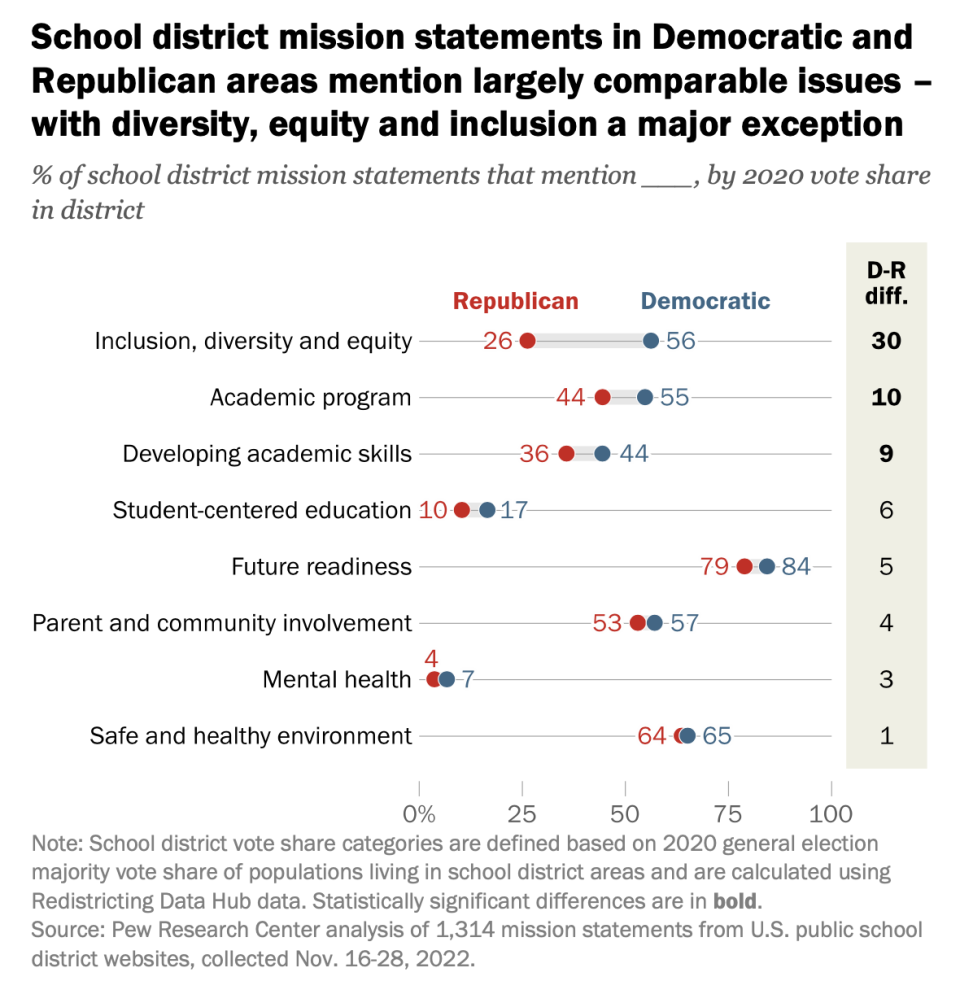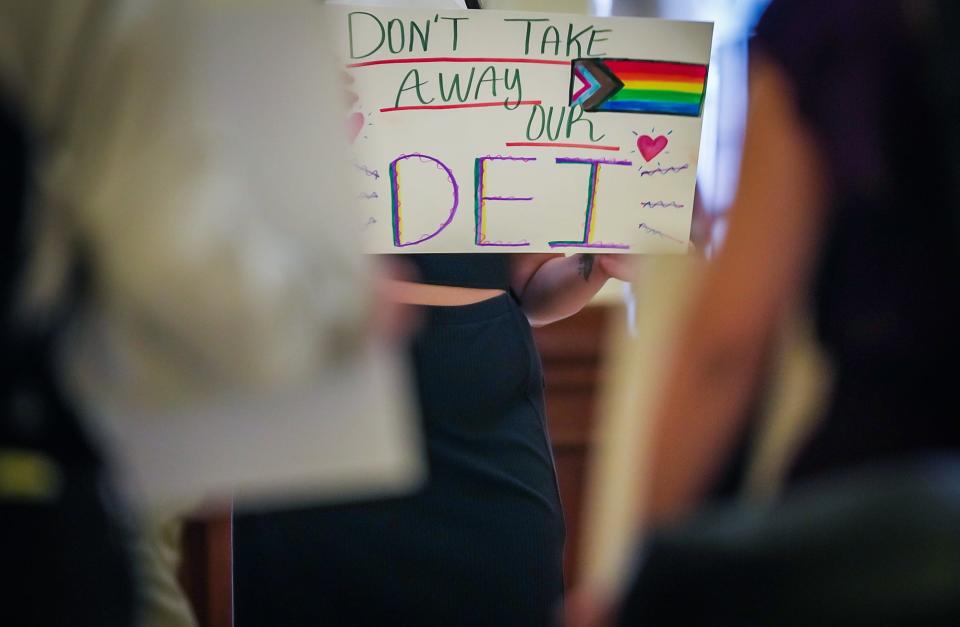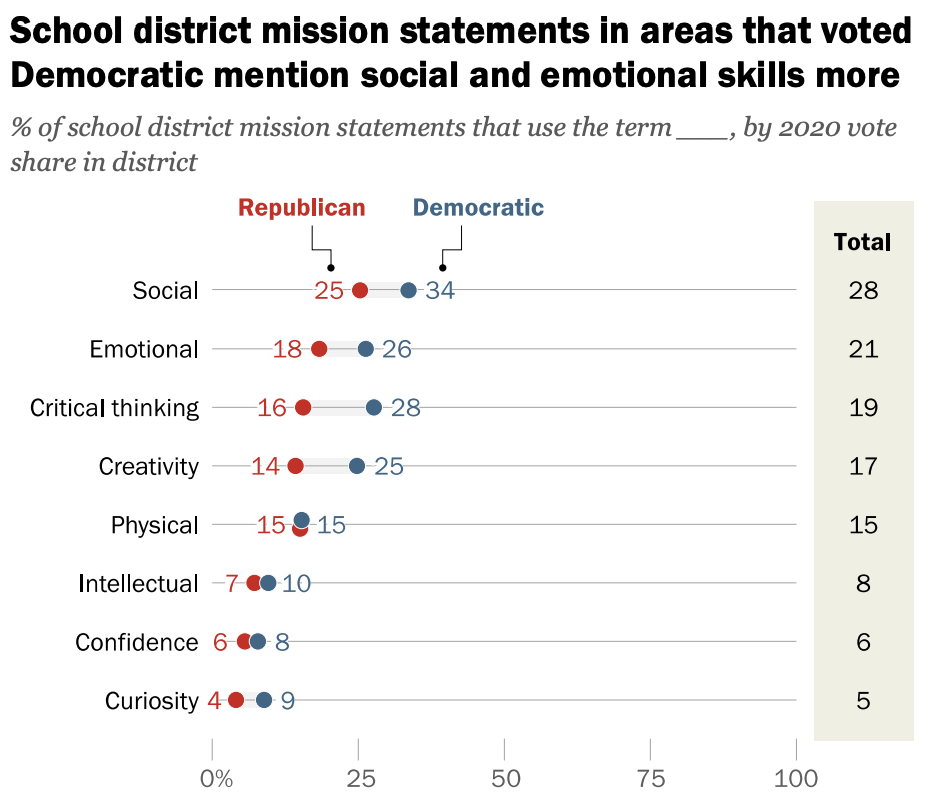Schools' mission statements tend to be the same. Except when it comes to diversity, equity
School district mission statements tend to be fairly unremarkable, run-of-the-mill documents. They usually say something about preparing students who are equipped to thrive in the modern economy and contribute to society. Many also commit to keeping those students safe and healthy, to involving parents and the community.
But a new analysis by the Pew Research Center reveals how districts’ mission statements are starting to reflect the culture wars over how race and gender are handled in schools.
Districts in Democratic-leaning areas, for example, are more than twice as likely as those in Republican ones to discuss diversity, equity and inclusion in their statements. Liberal districts are also more likely to embrace social-emotional learning, an educational model that teaches skills such as self-awareness, empathy and sharing that has become associated by conservatives with “woke indoctrination.”

“There was so much consistency” in the wording of districts’ mission statements “with the exception of this one basket of issues in particular,” said Aaron Smith, who led the Pew research project. “There’s a real divergence between red and blue districts – and also between urban or suburban districts and rural ones – in the extent to which they outwardly cite issues like diversity and inclusion as a core educational principle.”
More: Schools are becoming hotbeds of political conflict – especially in purple districts
Partisan divides over DEI
DEI has emerged as a bogeyman in conservative circles that decry it as leftist ideology rather than a set of policies and practices designed to make people of all backgrounds feel welcome and supported.
Why are colleges offering more DEI degrees? Demand for diversity expertise is growing.
Lawmakers in various red states are advancing legislation that would ban or restrict the use of DEI in public colleges and universities. But as the mission statement trends indicate, DEI is just as fraught at the K-12 level.
Just last week, parents, students and educators in Newton, Massachusetts, spent hours at a public hearing debating a petition to overturn DEI initiatives in local schools. The week before that, a Michigan middle school decided to postpone a diversity-focused day-long event and make it optional rather than mandatory after some critics accused organizers of spreading “Marxist ideals.”

The Pew analysis shows how these tensions may be influencing what districts choose to promote as their values. The researchers analyzed the mission statements of roughly 1,300 randomly selected districts nationwide and examined differences in part based on their residents’ presidential choices in the 2020 general election.
Blue- and red-leaning districts were more or less equally likely to mention most issues, from academic and career readiness to safe environments. But on DEI, the gap was glaring. Fifty-six percent of Democratic districts mention their DEI efforts, compared with just 26% of Republican ones.
And when zooming in on specific words within the DEI realm, the gaps are even greater. Almost no Republican districts – just 7% and 6%, respectively – mention “equity” and “inclusion" in their mission statements, for example, compared with 29% and 21% of Democratic districts.
DEI came to colleges with a bang: Now, these red states are on a mission to snuff it out.
These North Carolina counties were politically aligned: Education has divided them
Democratic, Republican parents diverge on social-emotional learning
Democratic districts were also more likely than Republican ones to use language associated with social-emotional learning. SEL, a framework that promotes interpersonal and personal skills as key to academic success, has like DEI become entangled in the culture wars over lessons about racism and LGBTQ+ issues.
This model teaches kids 'to be nice': It's controversial in Florida now under DeSantis.
While the language around SEL is “squishy,” making it more difficult to assess partisan differences, certain distinctions became clear. For one, left-leaning districts were more likely than right-leaning ones to use the word “social” in their mission statements (34% versus 25%) and to mention “critical thinking” (28% versus 16%).
“It’s notable because it doesn’t quite line up with the polling we’ve seen on this,” Smith said.

Indeed, separate surveys by Pew show majorities of both Democratic and Republican parents say it’s at least “very important” to them that their kids learn social and emotional skills at school.
More: Overhaul of Ohio colleges targets diversity mandates, China and requires U.S. history class
Contact Alia Wong at (202) 507-2256 or awong@usatoday.com. Follow her on Twitter at @aliaemily.
This article originally appeared on USA TODAY: Public schools' mission statements reflect partisan divide over DEI


